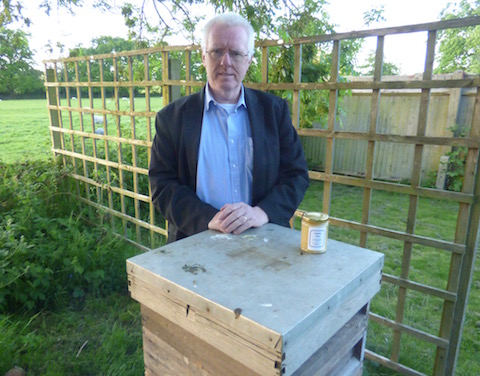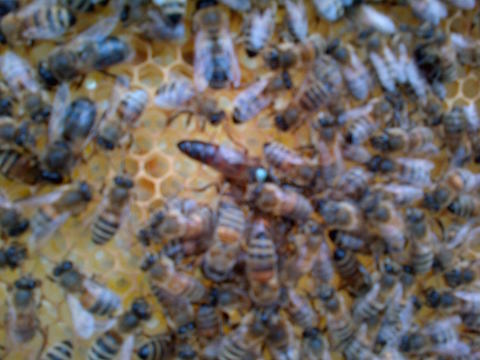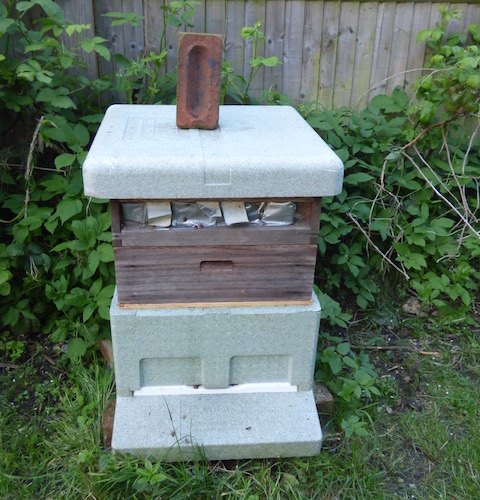 Abraham Lincoln
If given the truth, the people can be depended upon to meet any national crisis...
Abraham Lincoln
If given the truth, the people can be depended upon to meet any national crisis...
 Guildford news...
for Guildford people, brought to you by Guildford reporters - Guildford's own news service
Guildford news...
for Guildford people, brought to you by Guildford reporters - Guildford's own news service
Beekeeper’s Notes June 2015
Published on: 2 Jun, 2015
Updated on: 2 Jun, 2015
The Queen is dead – Long live the honeybee queen
In the second of beekeeper Hugh Coakley’s diary notes he describes how honeybees work only for the best interests of their colony, not the queen. Hugh lives in Worplesdon and has been keeping bees for six years and certainly knows a good deal about about the fascinating and complex lives of bees.
There is an oddity about our understanding of honeybees. The queen is central to the survival of the hive. She is called a queen but does she rule the colony or does she live, lay eggs and die at the behest of the workers who depend on her?
I inspect my bees weekly during the spring and summer. I try not to inspect just for interest, even though it is very interesting. There must always be a good reason to open the hive to the elements and disrupt the bees. At this time of year, the inspection is aimed at checking that all is well with the colony. Particularly to see if all is well with the queen. If there is a problem, there is a good chance that the beekeeper can help.
My bees at the moment are really lovely. Very passive – they don’t fly into my face when I open up the hive. And they are very sedate. By this I mean that they are not rushing around the comb but rather moving about slowly and calmly. This makes it much easier to inspect and it is a pleasure to work with them.
I have five hives, give or take the odd swarm or small colony. It takes me a total of two or three hours to do my weekly inspection and it is a very pleasant way to spend an afternoon.
The check-up the other week was interesting. Four of my hives were fine. The colonies were building up nicely. The queens were laying well, no obvious sign of disease, plenty of pollen and nectar being brought in. And I saw the queen in each hive which is very satisfying.
I have painted a spot on my queens to make it easier to see them (this is the accepted way to make the queen stand out). They are about 50% larger than the worker bees but as you can imagine, in amongst 20,000 to 50,000 bees, spotting one particular insect is not always easy. Especially if she is hiding. If you see eggs, you are pretty sure she is there. But it is lovely to see her anyway and admire her.
With a bit of luck, I would be able to harvest some spring honey, I thought.
On the fifth hive, I saw a capped queen cell and also one in preparation by the bees but not yet complete. A queen cell is a wax chamber which holds the developing queen larva and looks just like a peanut attached to the comb. We are taught that when you see a capped queen cell, one that is fully formed and closed, the bees have already swarmed or are about to swarm – bad thing.
Alternatively, they may be about to supersede (or replace) their queen with a new one – good thing. We are also taught that if there are many queen cells, it will be a swarm but only one or two queen cells, it is more likely to be a supercedure. So I was pleased. Only two queen cells, plenty of eggs so the queen is laying on full throttle. And then I spotted the queen herself. That confirmed it, I thought and I re-assembled the hive and closed it up for the week.
Unfortunately, the bees don’t read the same books as me.
The following week, I was called out to a swarm very near to my apiary. My suspicions were aroused. I opened up the hive and found a massive depletion of bee numbers – bad thing – no new eggs layed and no queen. So they had swarmed! So much for my ability to predict bee behaviour.
Now, back to the question of who rules the hive. It isn’t the queen. The queen does as she is told. The workers feed her but also, they can starve or kill her. They direct if, when and where she lays her eggs. They build her up or slim her down. The workers decide if their queen is not performing or if she is too old. It is cruel but they work only for the best interests of the colony, not the queen.
It ended well though. I managed to collect the swarm and they are doing nicely in a new hive. Once the new queen is mated and laying eggs, I will probably unite the swarm with one of my home colonies. As you can only have one queen, that will mean killing the old queen. It is a cruel world.
Recent Articles
- EasyJet to Run Its Full Half-term Flight Schedule Despite Strike Action
- Stoke Mill To Be a Pub If Plans Are Approved by Borough Council
- Notice: The Brigitte Trust’s Before I Say Goodbye Workshops
- Opinion: CIL Payments – These Residents Deserve Justice
- Letter: Zero Carbon – Nothing But Hot Exhaust
- Following Slaughter of Cow, Police Warn Public Not to Buy Unpackaged Meat
- New Signage at Nature Reserve Unveiled
- Flashback: Mansbridge Survives Unprecedented Challenge To His Council Leadership
- Brutal Thieves Slaughter Animal for Its Meat Which Could Cause Sickness If Eaten
- Highways Bulletin May 19 – Protecting Wildlife During Roadworks


Search in Site
Media Gallery
Dragon Interview: Local Artist Leaves Her Mark At One of England’s Most Historic Buildings
January 21, 2023 / No Comment / Read MoreDragon Interview: Lib Dem Planning Chair: ‘Current Policy Doesn’t Work for Local People’
January 19, 2023 / No Comment / Read MoreA3 Tunnel in Guildford ‘Necessary’ for New Homes, Says Guildford’s MP
January 10, 2023 / No Comment / Read More‘Madness’ for London Road Scheme to Go Ahead Against ‘Huge Opposition’, Says SCC Leader
January 6, 2023 / No Comment / Read MoreCouncillor’s Son Starts Campaign for More Consultation on North Street Plan
December 30, 2022 / No Comment / Read MoreCounty Council Climbs Down Over London Road Works – Further ‘Engagement’ Period Announced
December 14, 2022 / No Comment / Read MoreDragon Interview: GBC Reaction to the Government’s Expected Decision to Relax Housing Targets
December 7, 2022 / No Comment / Read MoreHow Can Our Town Centre Businesses Recover? Watch the Shop Front Debate
May 18, 2020 / No Comment / Read More













Recent Comments